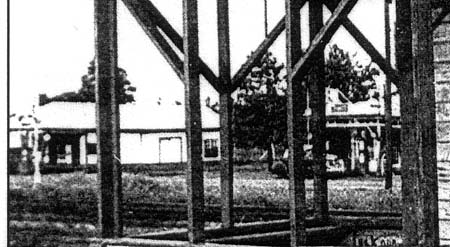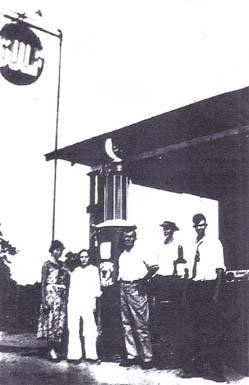Weisinger's Gulf Station

The only known photo of Uncle Bob Weisinger's Gulf Station (left) next door to Smith's Magnolia (right) viewed from railroad passenger shelter.
One of the least pretentious but most important businesses in Burke was the Gulf filling station operated by Robert E. "Uncle Bob" Weisinger (the man in khakis in the center of the adjacent photograph). It was located in "downtown" Burke on the west side of the Old Texas 35 directly across the railroad tracks from the Post Office.

Bob Weisinger (middle in
khakis)
with customers in
front of his station
Uncle Bob bought Earl Kellow's blacksmith shop in the 1920s and added a breezeway and living quartes in the rear.
The filling station was housed in a long, narrow, tin-roofed building with a hip roof overhang covering a gravel driveway.
On the outer edge of the covered drive stood two gas pumps dispensing "regular" and "ethyl" grades of gasoline. Until the mid-1950's the gas pumps were of the old cylindrical, gravity feed, glass tank type as shown in the adjacent photograph. A glass tank at the top would fill with gasoline of the desired amount, and you could watch the level go down as the gas was dispensed into the automobile. Later these were replaced with the square pumps topped with a lighted globe bearing the Gulf logo. The newer pumps still had a small sight glass and spinner to demonstrate to the customer that gasoline was actually being dispensed. A water faucet and an a coiled air hose were located between the pumps as well as an old barrel for empty oil cans.
Since Uncle Bob was elderly when the author was a boy, most of the service was self-service. Uncle Bob had a self-service filling station well before the rest of the world caught on. However, occassionally Uncle Bob would come out to help out. The author vividly remembers how meticulous he was in dispensing oil. The oil was opened and poured with a spout that included an integral punch that was pushed into the top of the can. Uncle Bob would wait for what seemed an eternity to let every possible drop of oil drain from the can. When he finished, he would remove the spout and wipe away any oil around the hole with his finger. Only then did he toss the can in the trash barrel.
The small store of sale goods was located in the front of the building adjacent the covered drive. The store was the old fashioned type with all the goods behind an L-shaped counter. In front of the counter was an a public area for customers with several chairs. In the winter Uncle Bob would install a wood heater in the public area. The author and his father spent many a Sunday afternoon sitting by the heater drinking a "soda water" as we called it then, talking to Uncle Bob.
The counter was split in the middle providing access to the goods and to the rear of the building. On the left side of the counter, Uncle Bob kept a small supply of automobile parts of unknown type and age. Farthest left on the side wall behind the foot of the L, he kept a supply of oil, both canned oil and bulk oil in quart jars with screw-on dispensers.
On the right end, the counter was formed by a red chest type cooler with the Coca Cola script logo splashed across the front. The drinks were cooled by a water bath. It was filled with Coke, Pepsi, Barq's Root Beer, Nehi Orange and Grape, and Dr. Pepper. To grab a soda water, you opened up the lid and pulled it out of the cold water. Behind the counter were various candies -- Butterfinger, Zero, Baby Ruth, Daffy Taffy, candy cigarettes, and Topps gum with baseball cards. The only grocery item that Uncle Bob carried was bread. The author's family bought several loaves once a week and kept them in a freezer until needed. Sales were rung up on an old mechanical cash register with drawer bell.
It was a big treat for a kid to go around behind the counter to select his own candy, but Uncle Bob would not let just any kid back there. He knew that candy would all too often disappear that way. But he trusted the author and would let him go behind the counter and decide between a Butterfinger and a Baby Ruth or select from several flavors of Laffy Taffy. That gave the author an important lesson on the value of honesty. He vividly remembers strutting away from Uncle Bob's store after one such experience feeling great pride at being accorded such trust.
Uncle Bob's living quarters were in the rear of the building with an enclosed breezeway garage separating it from the store. The author never saw the living quarters while Uncle Bob was living.
For many years Uncle Bob kept a mint condition Model T in the garage area. The author never saw him drive it although some say he drove it when he went hunting. He did his traveling to Lufkin by bus. It is said that the Ford dealer in Lufkin offered Uncle Bob a new automobile for the Model T, but Bob turned him down. Eventually he sold the old Tin Lizzie.
Uncle Bob was quite a gardener. In the fenced area beside and behind the station, Uncle Bob grew a meticlously groomed vegetable garden. Everyone said it was so neat because Uncle Bob was a German.
Uncle Bob 's service station was a weekly stop for the Murrah family. We visited the station every Sunday and bought 10 gallons of gas at 27.9 cents per gallon for our 1951 Chevy pickup. We never "filled up" because more was too expensive and 10 gallons to do everything we needed all week -- get Elroy Murrah to work all week, get the family to Lukin for shopping on Saturday, and do whatever was needed around the farm the rest of the week.
The author spent many hours as a kid sitting and listening to his father and Uncle Bob talking. He recalls Uncle Bob telling of shooting yellowhammer birds and selling them. He also recalls that Uncle Bob used to buy scrip from Southern Pine Lumber Company employees in Diboll at a discount so that would have cash to spend. At the time the Diboll was a completely "company town", and the sawmill paid its employees in scrip that could be used only at the company commissary. That obviously limited choice and eliminated price competition, and Uncle Bob was there to provide a service and to make money in the process.
One winter Sunday a local resident and his spoiled grandson were also there and sat around Uncle Bob's wood heater. The grandson would ask for a particular kind of soda, and his grandfather would pick it out of the cooler for him. The boy would take a sip or two and decide it was not what he wanted. The grandfather would get him a different type and drink the one the boy had abandoned. This continued until the boy had gone through at least a half dozen brands of soda, the grandfather dutifully drinking every drop of the leftovers.
Despite his modest dress and plain, out-of-date store, Uncle Bob was Burke's best businessman during his era. He knew how to make money and keep it. Uncle Bob used 15 watt light bulbs in the store and unwisely repaired his electrical drop cords by wrapping them with newspaper secured by twine.
The author's parents sold vegetables from their pickup in Diboll, and they would stop at Uncle Bob's store for change. My father told how once Uncle Bob brought out a bucket of nickels that had been around so long that they had begun to turn green with corrosion.
Despite his frugality, Uncle Bob was not stingy. He was Burke's informal banker, and he made loans to Burke people, including the author's father. He was also trustng when it was deserved. Uncle Bob sold on credit, and he kept his accounts on a lined card, one customer's name above the other. The author's father would write his own charges on the card and at the end of the month he would add them up himself and pay Uncle Bob. To start over he would simply erase his older charges from the card and begin again. Uncle Bob never checked his figures.
Sources:
- 1910 Census, Angelina County, Texas, Precinct 4 (Robert E. Kellow)
- 1920 Census, Angelina County, Texas, Precinct 4 (Earl Kellow)
- 1930 Census, Angelina County, Texas (Precinct 4 (Robert E. Weisinger)
- M. Lee Murrah, Personal Recollections